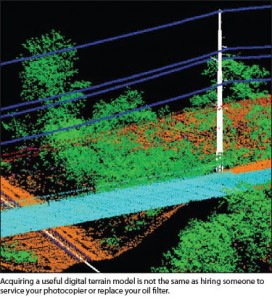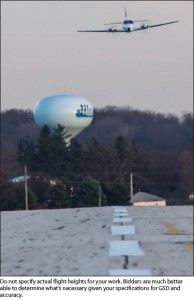By Mike Tully
Editor’s Note: This advice is directed at companies writing RFPs for your services; its language is humorous, but the tips are serious and worth sharing with your prospective clients in your own manner.
 I love Amazon.com. Knocking off my shopping list by finding the cheapest price for all is glorious. Reading real customer reviews about the product . . . priceless. By using Amazon-like tools, I am fairly certain that I’m getting the best price. However, professional services can’t and shouldn’t be procured as if they were widgets.
I love Amazon.com. Knocking off my shopping list by finding the cheapest price for all is glorious. Reading real customer reviews about the product . . . priceless. By using Amazon-like tools, I am fairly certain that I’m getting the best price. However, professional services can’t and shouldn’t be procured as if they were widgets.
We all want a deal. Shopping for the best price is a cherished economic freedom and produces downward pressure on price and upward pressure on value by encouraging innovation and performance.
As professionals procuring things, we are accountable to others for the money we spend and the things we buy. But professional services are not widgets. Your health is not a widget. Your tooth extraction is not a commodity item. Building a bridge or acquiring a useful digital terrain model (DTM) is not the same as hiring someone to service your photocopier or replace your oil filter.
There is value in how the dentist extracts my tooth, manages my pain, and treats me when I’m in his office or being billed. There is value in how a DTM is acquired and produced. Its accuracy and timely delivery add value. There are better ways to procure professional services than by shopping for simply the lowest price.
As our profession works through another procurement season and many RFPs for professional services hit the streets, I offer advice on ways NOT to procure professional geospatial services.
How NOT to Write a Solicitation
- Cut and paste specifications into your proposal from others if they are pretty close to what you want. A little ambiguity is okay.
- Be unclear in specifications, because we don’t mind comparing apples and oranges. What’s wrong with bidders making wild assumptions about what you really want and being unable to objectively score their proposals?
- Go ahead and use terms you don’t fully understand, e.g. topo, accuracy, geoid, DEM/DTM. That’s what everyone else says is needed.
- Don’t ensure that all the technical requirements are sufficiently described. It’s not really important to us to differentiate between acceptable and unacceptable bids or to discover a better approach among the proposals.
- Don’t have the RFP final draft reviewed by knowledgeable professionals to ensure it is clear and aligned with our actual needs. We love to answer dozens of questions from respondents about the same puzzling specification.
- Use the same specs as last year. Technology and innovation never occur.
- Set the minimum acceptable technical and performance requirements low so everyone can bid, even the unqualified.
- Specify the actual flight heights from which you want your imagery and lidar acquired. After all, aren’t all sensors the same? You may not be an operator of that sophisticated equipment, but you think you do know how best to acquire the data.
 Professional geospatial services are, by definition, complex. Every procurement is unique; it’s not like making Frisbees. Weather, stakeholder demands, equipment performance, and a variety of other factors contribute to a project’s complexity.
Professional geospatial services are, by definition, complex. Every procurement is unique; it’s not like making Frisbees. Weather, stakeholder demands, equipment performance, and a variety of other factors contribute to a project’s complexity.
Further, professional standards of accuracy and quality continue to evolve as technology advances. Technical specifications need to align with unique stakeholders’ needs. It is imperative that those writing the RFP understand the relevant technology and how to clearly define specifications. The writers need not be experts, but they must understand the basics. If not, get help from those service providers or other neutral third parties.
If specifications and minimum acceptable requirements are too low, then marginally acceptable bidders become candidates for contract award, low price becomes the determining factor, and the risk of project failure, threats to the public, and low-quality deliverables are more likely. Real value declines.
Setting good minimum standards also protects the client and providers from positive bias toward those bidders who are able to far exceed those minimums. For example, the smaller company with less but acceptable experience still passes the threshold and can compete on equal footing with the larger firm. A small firm’s innovation and responsiveness can win them a seat at the table and ultimately bring additional value to the stakeholders.
Not all projects can have clear specifications at the outset because of their complexity or novelty. Sometimes new technology is being used. Sometimes no provider has tons of experience using it, and “how to do it” and its associated costs are simply unknown. In these cases, specify a pilot project. This will help the client and provider work out these details and set a reasonable price based on real-world experience doing the needed work.
Clients should not dictate how the work should be done, but instead should simply define what the deliverable needs to be. Don’t ask for more quality or accuracy than your stakeholders really need, or you’re wasting money and losing value.
Finally, don’t recycle ambiguous, unneeded RFP language.
How TO Write a Solicitation
- Set related project experience specifications. Require a minimum number of similar projects to have been completed in the last 12-24 months to demonstrate familiarity and experience with the work.
- Require key project personnel to meet minimum experience and education thresholds. That said, don’t make these arbitrary. You don’t want qualified bidders disqualified simply because a proven project manager didn’t have a master’s degree in geography, for example.
- Set technical standards such that inferior or marginal equipment cannot be used.
- Set clear and appropriate positional accuracy standards so sub-par work is not allowed and quality can be objectively measured in the deliverables. I can’t count the number of times I’ve heard from stakeholders a sincere desire for accuracy, but their RFP criteria fail to set meaningful, measurable standards.
Why Go Low Bid?
- If you are still determined to “go low bid,” here are some excellent reasons to do so.
- You love sub-par contract staffing, marginal technical accomplishment, late deliveries, and cost overruns.
- You want to encourage contractors to pay the lowest possible amount to the least-qualified staff, cut corners, and keep unemployment high.
- You enjoy adversarial relationships with providers as their performance slides and your (unrealistic) expectations of timeliness and quality erode.
- You love explaining to your board why more money is needed to get the job done or the deliverables you received are sub-par.
- You don’t want to have confidence that the geospatial data received really is fit for its intended use.
- You don’t care about the best way, just the cheapest.
Lowest price bidding is inappropriate for professional services. When the client applies this strategy to unsuitable procurements, both the client and the providers lose. When the client is a government entity, we all lose because our taxes are being wasted on inefficient and possibly unsafe and unneeded, low-value services.
Generally, as price is pushed downward, performance risk goes up. At the end of the day, the lowest bidder’s reputation suffers, their fiscal health is probably hurt because of low or negative profitability, and the client is criticized for cost and schedule overruns and for failing to manage their program correctly. In the end, everyone loses, and the initial satisfaction of saving a few thousand bucks is often overshadowed by the burden of poor contractor performance.
When clients use qualifications-based selection (QBS) or best-value procurements (where price is not a consideration until after the most qualified firms have been identified), they recognize that there is value in non-cost factors such as public safety, public welfare, technical approach, management plan, and past performance. These tradeoffs give the client the latitude to award a contract to other than the lowest-priced provider because of that added value.
The Brooks Law, adopted by Congress in 1972, was amended in 1989 to add that qualifications-based selection procedures apply to the professional services of surveying and mapping. QBS is simple.
How to Use QBS
- Write the RFP clearly, setting minimum selection criteria.
- Select the most qualified firm.
- Define the scope of services that optimizes value to all stakeholders.
- Negotiate the price with the most qualified provider.
- Retain the geospatial firm.
If an acceptable price cannot be negotiated with your first pick, move on to the second most qualified firm. The beauty of this contracting approach is that the second and third firms on the list are both qualified. The good specifications and project approach devised in consultation with the experts have minimized (not eliminated) the risk that the client will get an unqualified firm or sub-standard performance.
As you procure professional geospatial services for 2014, be smart. Get the best deal with the most value for your stakeholders. The contracts with the most value are seldom found among the bottom feeders. Professional services should not be contracted as if they were simple widgets. Unlike widgets, every geospatial project is unique and requires sophisticated technology and the seasoned judgment of professionals to balance a thousand factors. Find the best value for your projects by writing solicitations clearly and selecting firms based on qualifications, not price.
Sample Unhelpful Requests
“A USGS camera calibration report, no more than three years old…”
Modern cameras don’t have USGS calibration reports.
“Spot elevations will be complete and accurate.”
How precisely is this measured? To what standard?
“Flight acquisition must occur between 10am and 2pm … and be acquired with a minimum of 30 degree sun angle.”
Just specify the sun angle. The provider will ensure it is collected correctly.
